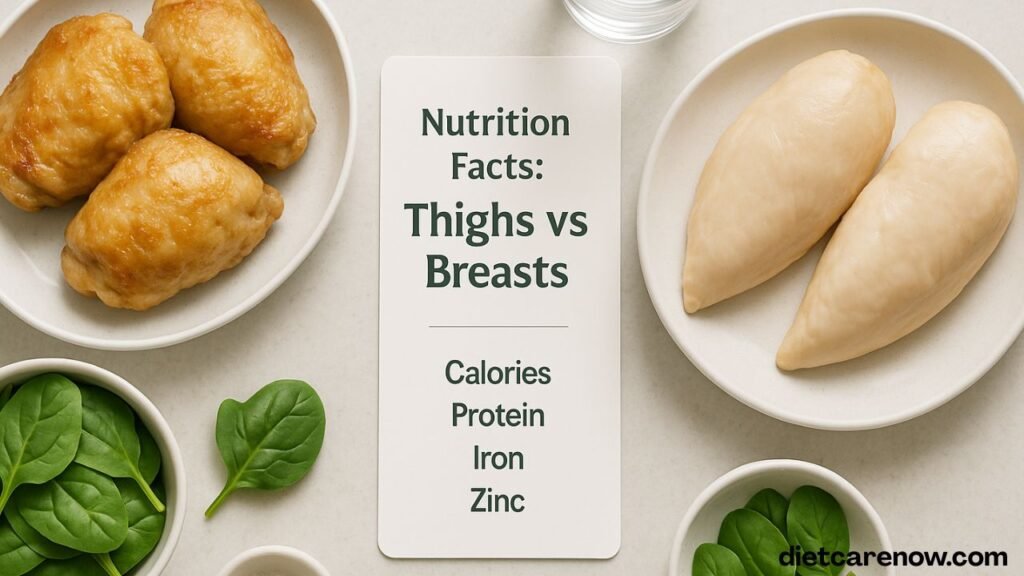Chicken is one of the most popular proteins in the world, loved for its versatility, affordability, and ability to adapt to nearly every cuisine. But when it comes to choosing the right cut, there’s an age-old debate: are chicken thighs dark meat, and what does that really mean?
This question isn’t just for curious home cooks. It matters to health-conscious eaters, athletes planning their nutrition, and anyone who wants to get the best flavor and value out of their meals. Understanding the difference between white and dark meat helps you choose the right cut for your goals—whether that’s building muscle, saving money, or simply enjoying the most flavorful dinner possible.
Understanding Poultry Meat Types
Chicken meat is divided into two main categories: white meat and dark meat. Here’s what sets them apart:
- White Meat (breast, wings):
- Made up mostly of fast-twitch muscle fibers, which are designed for quick, short bursts of activity (like flapping).
- Low in myoglobin (the protein that stores oxygen in muscles), which is why it looks paler when cooked.
- Dark Meat (thighs, drumsticks):
- Contains mostly slow-twitch fibers, built for endurance (like standing and walking).
- Higher in myoglobin, which gives the meat its deeper reddish-brown hue before cooking.
The key difference comes down to myoglobin. More myoglobin = darker color = richer flavor.
Also read: /hot-and-sour-soup/
Are Chicken Thighs Dark Meat?
The short answer: Yes, chicken thighs are dark meat.
Thighs are the muscles chickens use most for walking and standing, so they are full of slow-twitch fibers and packed with myoglobin. That’s why they appear darker than breast meat, especially before cooking.
Compared to drumsticks, thighs are slightly less dark but still firmly classified as dark meat. Together, the thighs and drumsticks make up the bulk of a chicken’s dark-meat section.

Nutritional Profile of Chicken Thighs
Chicken thighs offer a different nutritional balance than chicken breasts. They’re slightly higher in fat and calories but also richer in certain micronutrients.
Here’s a comparison of 100 grams (3.5 oz), cooked, skinless chicken:
| Nutrient | Chicken Breast (White Meat) | Chicken Thigh (Dark Meat) |
|---|---|---|
| Calories | ~165 kcal | ~209 kcal |
| Protein | 31 g | 26 g |
| Fat | 3.6 g | 10.9 g |
| Iron | 0.7 mg | 1.3 mg |
| Zinc | 0.7 mg | 2.0 mg |
| Vitamin B6 | 0.6 mg | 0.5 mg |
| Vitamin B12 | 0.2 mcg | 0.3 mcg |
Key takeaway:
- Breasts win on lean protein and lower calories.
- Thighs win on iron, zinc, and richness in healthy fats.
Flavor and Texture Differences
If you’ve ever bitten into a juicy chicken thigh, you know the difference instantly.
- Flavor: Thighs taste richer and more savory thanks to their higher fat content.
- Texture: They’re tender and moist, even when cooked for longer periods.
- Cooking benefits: Unlike chicken breasts, thighs don’t dry out easily, making them ideal for slow cooking, braising, or grilling.
This is why chefs often prefer thighs for recipes that demand deep flavor and resilience.
Chicken Thighs vs Chicken Breasts: A Side-by-Side Comparison
| Feature | Chicken Breasts (White Meat) | Chicken Thighs (Dark Meat) |
|---|---|---|
| Flavor | Mild, neutral | Rich, savory |
| Texture | Can dry out, lean | Juicy, tender |
| Nutrition | High protein, low fat | Moderate protein, higher fat |
| Cooking Methods | Quick cooking (grilling, stir-frying) | Slow cooking, braising, grilling |
| Cost | Usually more expensive | More affordable |
| Best For | Dieting, lean meals | Flavorful dishes, budget cooking |
Which should you choose?
- For low-calorie, high-protein diets: go with breasts.
- For taste, juiciness, and value: thighs win hands down.
Health Benefits of Dark Meat
Many people assume white meat is healthier, but dark meat has unique advantages:
- Iron & Zinc: Essential for energy, immunity, and overall health.
- Healthy Fats: Provide satiety and long-lasting energy.
- B Vitamins: Especially niacin (B3) and B12, important for metabolism and nervous system function.
Dark meat isn’t “bad.” In fact, when eaten in moderation, it adds valuable nutrients often missing in a strictly white-meat diet.
Common Misconceptions About Dark Meat
- Myth: Dark meat is unhealthy.
- Truth: The higher fat is mostly monounsaturated and polyunsaturated, not just saturated. It can support heart health when balanced in a diet.
- Myth: White meat is always better.
- Truth: Both have benefits—white for lean protein, dark for micronutrients.
- Myth: Dark meat equals “junk food.”
- Truth: Cooking methods matter more than the cut. Grilled or roasted thighs are far healthier than deep-fried breasts.
Cultural habits also play a role: in the U.S., breasts are prized, but in Asia, Africa, and Europe, thighs are often considered the tastiest part of the bird.

Cooking Chicken Thighs: Methods & Tips
Thighs are versatile and forgiving in the kitchen.
Best cooking methods:
- Grilling: Crispy outside, juicy inside.
- Roasting: Simple, hands-off method for family dinners.
- Braising/Stewing: Ideal for curries, coq au vin, or slow cooker meals.
- Air Frying: Healthier way to get crispy skin.
Tips:
- Trim extra skin or fat if you’re watching calories.
- Marinate for deeper flavor.
- Don’t overcook: thighs are safe at 165°F (74°C) but remain moist even beyond that point.
Cost & Accessibility of Chicken Thighs
One big advantage of thighs is their price. In most supermarkets, thighs are cheaper per pound than breasts, making them perfect for families and budget-friendly meal planning.
Globally, preferences vary:
- U.S.: Breasts are more popular, making thighs cheaper.
- Asia & Africa: Dark meat is often more desirable and may cost more.
This makes thighs not only delicious but also a smart economic choice.
Health Considerations: Who Should Choose Dark Meat?
- Athletes: Extra iron and zinc support endurance and muscle recovery.
- Children & Teens: Growing bodies benefit from the added nutrients.
- People with anemia: Higher iron levels help boost red blood cell production.
For those aiming for weight loss, thighs can still fit in—just choose skinless cuts and bake or grill instead of frying.
Skin-On vs Skinless Chicken Thighs
| Feature | Skin-On Thighs | Skinless Thighs |
|---|---|---|
| Calories (per 100 g) | ~229 kcal | ~209 kcal |
| Fat | 15 g | 10.9 g |
| Texture | Crisp, flavorful | Leaner, lighter |
| Best Uses | Grilling, roasting | Stir-fries, curries, diet-friendly dishes |
The skin adds both flavor and fat. If you love crispy texture, skin-on is worth it; if you’re counting calories, skinless is the better choice.
Dark Meat in Global Cuisines
Chicken thighs shine in recipes worldwide:
- France: Coq au Vin – chicken braised in wine with mushrooms.
- Japan: Karaage – soy-marinated fried chicken bites.
- India: Chicken curry – thighs stay tender in long simmering sauces.
- USA: BBQ smoked chicken thighs – juicy, flavorful, and affordable.
In many traditions, thighs are considered superior to breasts for their ability to hold flavor.
Storage, Safety & Preparation Tips
Chicken must always be handled carefully:
- Storage:
- Raw thighs: 1–2 days in the fridge, up to 9 months frozen.
- Cooked thighs: 3–4 days in the fridge.
- Safety:
- Wash hands and surfaces after handling raw chicken.
- Never wash raw chicken—it spreads bacteria.
- Cook to at least 165°F (74°C) internal temperature.
Food safety ensures you enjoy thighs without health risks.

Conclusion: Why Chicken Thighs Deserve a Place on Your Plate
So, are chicken thighs dark meat? Absolutely. They’re flavorful, nutrient-rich, and affordable, offering a balance that chicken breasts alone can’t provide.
By understanding their nutritional value, cooking methods, and role in global cuisine, you can appreciate thighs not as “lesser cuts,” but as the secret stars of the chicken world.
Next time you’re meal-planning, don’t shy away from the thighs. Embrace them for what they are: dark, delicious, and downright versatile.

